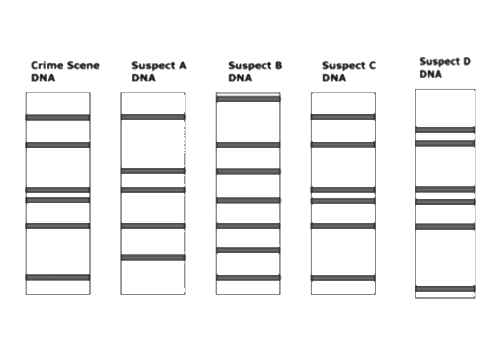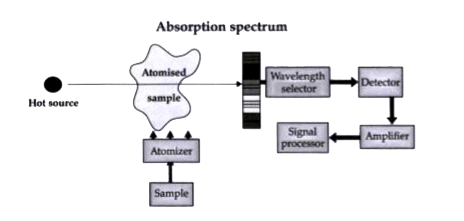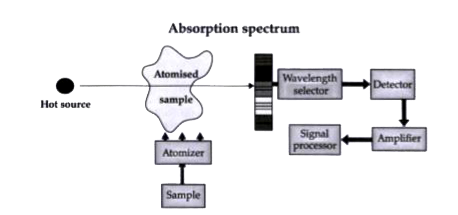Using the tissue sample found at the crime scene, the forensic investigator ran a DNA analysis with four suspects and the results obtained are shown in the below image. Determine the suspect having the highest probability of been present at the crime scene.

Suspect A
Suspect B
Suspect C
Suspect D
The correct Answer is:C
Step by step video & image solution for Using the tissue sample found at the crime scene, the forensic investigator ran a DNA analysis with four suspects and the results obtained are shown in the below image. Determine the suspect having the highest probability of been present at the crime scene. by Biology experts to help you in doubts & scoring excellent marks in Class 12 exams.
Updated on:21/07/2023Topper's Solved these Questions
Similar Questions
Molecules of the amino acids that comprise our proteins have the property of being non-super imposable on their mirror images because,. They are said to be chiral or possess 'handedness'. Most of the amino acids are of left handed form, but with no reasons available. Even more interesting recent experiments have shown that a 7-9% excess of four amino acids is present in Murchison meteorite discovered in 1970. This analysis shows life could arise outside the confines of earth. The origin of unequal distribution is probably because of electromagnetic radiations emitted in a corkscrew fashion from the poles of spinning neutron stars could lead to a bias of one mirror image isomer over another when molecules form in interstellar space.
A stereogenic carbon can be defined as a carbon atom bearing groups of such nature that an interchange of any two groups will produce a stereoisomer. The device that is used for measuring the effect of optically active compounds on plane polarized light is a polarimeter. The analyser in the polarimeter decides the activity of compound present. This is being decided on the basis of angle by which axis of analyser has to be rotated for complete brightness. Left, right or no adjustment decides l, d - activity or optical inactivity respectively.
EMR emitted in corkscrew fashion from poles of spinning neutrons are biased to
View SolutionMolecules of the amino acids that comprise our proteins have the property of being non-super imposable on their mirror images because,. They are said to be chiral or possess 'handedness'. Most of the amino acids are of left handed form, but with no reasons available. Even more interesting recent experiments have shown that a 7-9% excess of four amino acids is present in Murchison meteorite discovered in 1970. This analysis shows life could arise outside the confines of earth. The origin of unequal distribution is probably because of electromagnetic radiations emitted in a corkscrew fashion from the poles of spinning neutron stars could lead to a bias of one mirror image isomer over another when molecules form in interstellar space.
A stereogenic carbon can be defined as a carbon atom bearing groups of such nature that an interchange of any two groups will produce a stereoisomer. The device that is used for measuring the effect of optically active compounds on plane polarized light is a polarimeter. The analyser in the polarimeter decides the activity of compound present. This is being decided on the basis of angle by which axis of analyser has to be rotated for complete brightness. Left, right or no adjustment decides l, d - activity or optical inactivity respectively.
Optically inactive isomer possessing chiral centres are categorized as
View Solution
Knowledge Check
A crime is committed by one of two suspects, A and B. Initially, there is equal evidence against both of them. In further investigation at the crime scene, it is found that the guilty party had a blood type found in 20% of the population. If the suspect A does match this blood type , whereas the blood type of suspect B is unknown, then the probability that A is guilty party =
A3/5B5/6C1/3D2/3Read the following text and answer the following questions on the basis of the same:
Atomic Absorption Spectrometer: The atomic absorption (AA) spectrometer is used to analyze metals at very low concentrations, typically in the parts per million (ppm) or parts per billion (ppb) ranges. A liquid sample containing dissolved material whose concentration is to be measured is aspirated into a thin, wide AA flame, or is introduced into a small carbon furnace which is heated to a high temperature.

Basic Principle of AAS is the measurement of absorption of radiation by free atoms. The total amount of absorption depends on the number of free atoms present and the degreee to which the free atoms absorb the radiation. At the high temperature of the AA flame, the sample is broken down into atoms using an atomizer and it is the concentration of these atoms that is measured. Sample in the form of solution is used. It is broken up into a fine mist with the help of an atomizer. When the mist reaches the flame, the intense heat breaks up the sample into its individual atoms. When a photon coming out from the hot source hits an atom and the energy of the photon is equal to the gap between two electron energy levels of the atom, then the electron in the lower energy level absorb the photon and jumps up to the higher energy level. If the photon energy does not correspond to the difference between two energy levels, then the photon will not be absorbed (it may be scattered away). Hence in the spectrum, the wavelength corresponding to the absorbed photons is observed as black lines as shown in the following spectrum of Hydrogen. The dark lines correspon to the frequencies of light those have been absorbed by the sample element. Using this process, a source of photons (generally a white light) of various energies is used to obtain the absorption spectra of different materials and to identify them.
What should be the concentration of metal for analysis using Atomic Absorption Spectrometer?AVery High concentrationBVery low concentrationCMedium concentrationDAny concentrationMolecules of the amino acids that comprise our proteins have the property of being non-super imposable on their mirror images because,. They are said to be chiral or possess 'handedness'. Most of the amino acids are of left handed form, but with no reasons available. Even more interesting recent experiments have shown that a 7-9% excess of four amino acids is present in Murchison meteorite discovered in 1970. This analysis shows life could arise outside the confines of earth. The origin of unequal distribution is probably because of electromagnetic radiations emitted in a corkscrew fashion from the poles of spinning neutron stars could lead to a bias of one mirror image isomer over another when molecules form in interstellar space.
A stereogenic carbon can be defined as a carbon atom bearing groups of such nature that an interchange of any two groups will produce a stereoisomer. The device that is used for measuring the effect of optically active compounds on plane polarized light is a polarimeter. The analyser in the polarimeter decides the activity of compound present. This is being decided on the basis of angle by which axis of analyser has to be rotated for complete brightness. Left, right or no adjustment decides l, d - activity or optical inactivity respectively.
Stereogenic carbons can bringAoptical activityBoptical inactivityCbothDNone of the above
Molecules of the amino acids that comprise our proteins have the property of being non-super imposable on their mirror images because,. They are said to be chiral or possess 'handedness'. Most of the amino acids are of left handed form, but with no reasons available. Even more interesting recent experiments have shown that a 7-9% excess of four amino acids is present in Murchison meteorite discovered in 1970. This analysis shows life could arise outside the confines of earth. The origin of unequal distribution is probably because of electromagnetic radiations emitted in a corkscrew fashion from the poles of spinning neutron stars could lead to a bias of one mirror image isomer over another when molecules form in interstellar space.
A stereogenic carbon can be defined as a carbon atom bearing groups of such nature that an interchange of any two groups will produce a stereoisomer. The device that is used for measuring the effect of optically active compounds on plane polarized light is a polarimeter. The analyser in the polarimeter decides the activity of compound present. This is being decided on the basis of angle by which axis of analyser has to be rotated for complete brightness. Left, right or no adjustment decides l, d - activity or optical inactivity respectively.
For existence of life, amino acids as ingredient of protein exist mainly in
View SolutionRead the following text and answer the following questions on the basis of the same:
Atomic Absorption Spectrometer: The atomic absorption (AA) spectrometer is used to analyze metals at very low concentrations, typically in the parts per million (ppm) or parts per billion (ppb) ranges. A liquid sample containing dissolved material whose concentration is to be measured is aspirated into a thin, wide AA flame, or is introduced into a small carbon furnace which is heated to a high temperature.

Basic Principle of AAS is the measurement of absorption of radiation by free atoms. The total amount of absorption depends on the number of free atoms present and the degreee to which the free atoms absorb the radiation. At the high temperature of the AA flame, the sample is broken down into atoms using an atomizer and it is the concentration of these atoms that is measured. Sample in the form of solution is used. It is broken up into a fine mist with the help of an atomizer. When the mist reaches the flame, the intense heat breaks up the sample into its individual atoms. When a photon coming out from the hot source hits an atom and the energy of the photon is equal to the gap between two electron energy levels of the atom, then the electron in the lower energy level absorb the photon and jumps up to the higher energy level. If the photon energy does not correspond to the difference between two energy levels, then the photon will not be absorbed (it may be scattered away). Hence in the spectrum, the wavelength corresponding to the absorbed photons is observed as black lines as shown in the following spectrum of Hydrogen. The dark lines correspon to the frequencies of light those have been absorbed by the sample element. Using this process, a source of photons (generally a white light) of various energies is used to obtain the absorption spectra of different materials and to identify them.
How the sample for analysis is deriven to atomic state in AAS?
View SolutionRead the source given below and answer the questions that follows: In 1848, Frederic Sorrieu, a French artist, prepared a series of four prints visualising his dream of a world made up of 'democratic and social Republics', as he called them. The first print of the series, shows the peoples of Europe and America - men and women of all ages and social classes - marching in a long train, and offering homage to the statue of Liberty as they pass by it. As you would recall, artists of the time of the French Revolution personified Liberty as a female figure - here you can recognise the torch of Enlightenment she bears in one hand and the Charter of the Rights of Man in the other. On the earth in the foreground of the image lie the shattered remains of the symbols of absolutist institutions. In Sorrieu's utopian vision, the peoples of the world are grouped as distinct nations, identified through their flags and national costume. Leading the procession, way past the statue of Liberty, are the United States and Switzerland, which by this time were already nation-states. France, identifiable by the revolutionary tricolour, has just reached the statue. She is followed by the peoples of Germany, bearing the black, red and gold flag. Interestingly, at the time when Sorrieu created this image, the German peoples did not yet exist as a united nation - the flag they carry is an expression of liberal hopes in 1848 to unify the numerous German-speaking principalities into a nation-state under a democratic constitution. Following the German peoples are the peoples of Austria, the Kingdom of the Two Sicilies, Lombardy, Poland, England, Ireland, Hungary and Russia. From the heavens above, Christ, saints and angel's gaze upon the scene. They have been used by the artist to symbolise fraternity among the nations of the world.
Which country was yet not recognised as a nation state when this image was created?
View SolutionRead the source given below and answer the questions that follows: In 1848, Frederic Sorrieu, a French artist, prepared a series of four prints visualising his dream of a world made up of 'democratic and social Republics', as he called them. The first print of the series, shows the peoples of Europe and America - men and women of all ages and social classes - marching in a long train, and offering homage to the statue of Liberty as they pass by it. As you would recall, artists of the time of the French Revolution personified Liberty as a female figure - here you can recognise the torch of Enlightenment she bears in one hand and the Charter of the Rights of Man in the other. On the earth in the foreground of the image lie the shattered remains of the symbols of absolutist institutions. In Sorrieu's utopian vision, the peoples of the world are grouped as distinct nations, identified through their flags and national costume. Leading the procession, way past the statue of Liberty, are the United States and Switzerland, which by this time were already nation-states. France, identifiable by the revolutionary tricolour, has just reached the statue. She is followed by the peoples of Germany, bearing the black, red and gold flag. Interestingly, at the time when Sorrieu created this image, the German peoples did not yet exist as a united nation - the flag they carry is an expression of liberal hopes in 1848 to unify the numerous German-speaking principalities into a nation-state under a democratic constitution. Following the German peoples are the peoples of Austria, the Kingdom of the Two Sicilies, Lombardy, Poland, England, Ireland, Hungary and Russia. From the heavens above, Christ, saints and angel's gaze upon the scene. They have been used by the artist to symbolise fraternity among the nations of the world.
Which people were portrayed in Sorrieu's first print?
View SolutionRead the source given below and answer the questions that follows: In 1848, Frederic Sorrieu, a French artist, prepared a series of four prints visualising his dream of a world made up of 'democratic and social Republics', as he called them. The first print of the series, shows the peoples of Europe and America - men and women of all ages and social classes - marching in a long train, and offering homage to the statue of Liberty as they pass by it. As you would recall, artists of the time of the French Revolution personified Liberty as a female figure - here you can recognise the torch of Enlightenment she bears in one hand and the Charter of the Rights of Man in the other. On the earth in the foreground of the image lie the shattered remains of the symbols of absolutist institutions. In Sorrieu's utopian vision, the peoples of the world are grouped as distinct nations, identified through their flags and national costume. Leading the procession, way past the statue of Liberty, are the United States and Switzerland, which by this time were already nation-states. France, identifiable by the revolutionary tricolour, has just reached the statue. She is followed by the peoples of Germany, bearing the black, red and gold flag. Interestingly, at the time when Sorrieu created this image, the German peoples did not yet exist as a united nation - the flag they carry is an expression of liberal hopes in 1848 to unify the numerous German-speaking principalities into a nation-state under a democratic constitution. Following the German peoples are the peoples of Austria, the Kingdom of the Two Sicilies, Lombardy, Poland, England, Ireland, Hungary and Russia. From the heavens above, Christ, saints and angel's gaze upon the scene. They have been used by the artist to symbolise fraternity among the nations of the world.
What is identified by the different flags and costumes worn by the people?
View Solution
